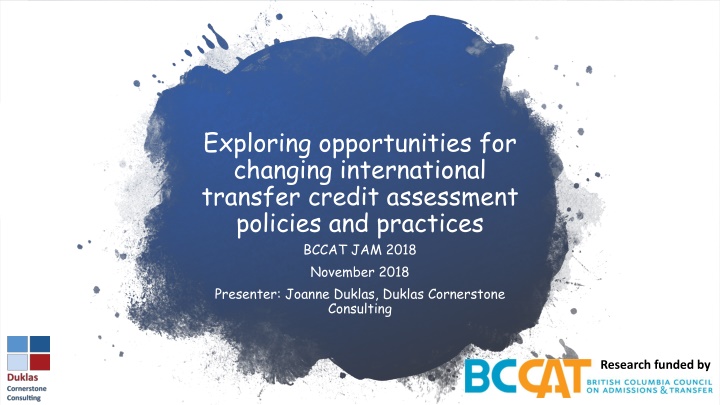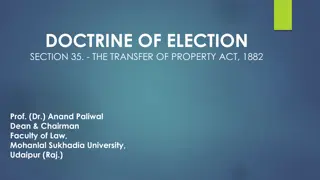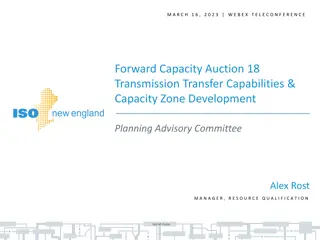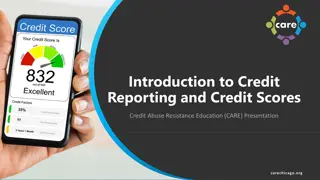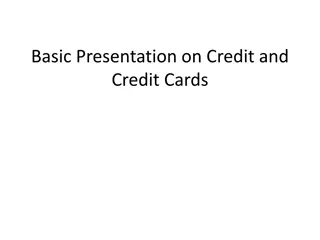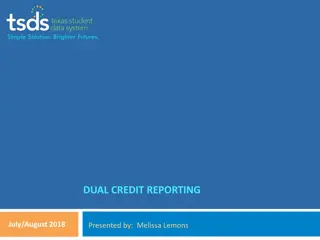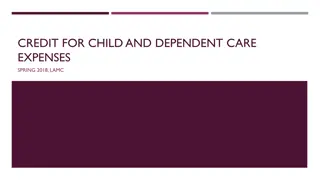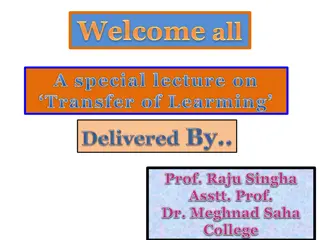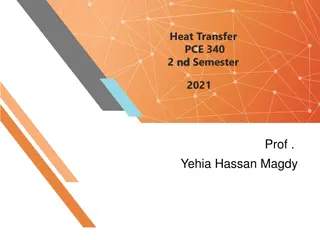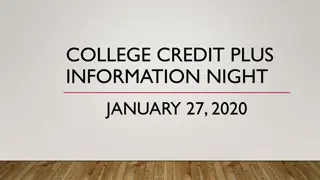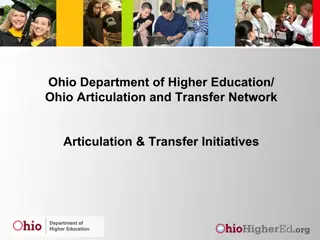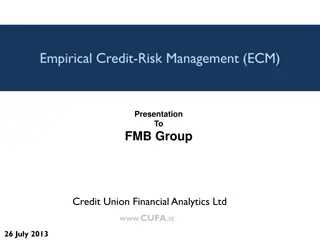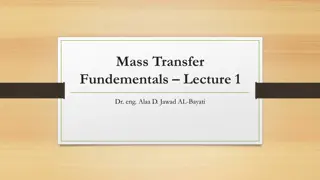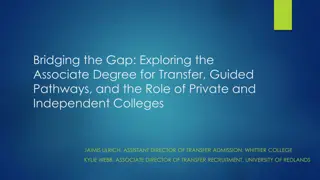Changing International Transfer Credit Policies
This study delves into opportunities for altering international transfer credit assessment policies and practices, highlighting findings, reflections, and research scope. It examines the impetus behind the research, the methodology used, sample limitations, key definitions, and critical aspects of transfer credit assessment. The research was funded by various entities and involved a comprehensive review of practices at BC member institutions as well as national and international organizations.
Download Presentation

Please find below an Image/Link to download the presentation.
The content on the website is provided AS IS for your information and personal use only. It may not be sold, licensed, or shared on other websites without obtaining consent from the author.If you encounter any issues during the download, it is possible that the publisher has removed the file from their server.
You are allowed to download the files provided on this website for personal or commercial use, subject to the condition that they are used lawfully. All files are the property of their respective owners.
The content on the website is provided AS IS for your information and personal use only. It may not be sold, licensed, or shared on other websites without obtaining consent from the author.
E N D
Presentation Transcript
Exploring opportunities for changing international transfer credit assessment policies and practices BCCAT JAM 2018 November 2018 Presenter: Joanne Duklas, Duklas Cornerstone Consulting Research funded by Research funded by
Overview of Study Findings Plan Reflections Questions & Discussion Research funded by Research funded by
Research Project Scope 1 2 Research funded by
Research Impetus BCCAT Study - Transfer Credit Assessment: A Survey of Institutional Practices (January 2015) examined transfer credit practices at BC member institutions assessment of international transfer courses could serve as a focus for future research (p. 7). BC International Education Strategy Transfer & Articulation Committee, BCCAT Research funded by
Research Approach National & international web site & literature review BC & Canadian Post-Secondary Institutions; Allied Associations; Government Mandated Service Providers; Councils on Articulation/Admissions & Transfer; Credential Evaluators; International Organizations Interviews with allied organizations supplemented by additional research and conference meetings Canadian Information Centre for International Credentials; Fall PESC Data Summit; Spring Groningen Summit; etc. National survey 95 Respondents; 81 Institutions; 43% institutional Response Rate (Public); 82% Completion Rate Institutional field interviews - UBC, UVic, TRU, CapU, COTR, LANG, Humber, Ryerson 8 3 RUCBC; 2 BC Colleges; 1 BCAIU; 1 Polytechnic; 1 University (used to be a Polytechnic) Institutional web site reviews Publicly funded BC institutions and select other Canadian institutions Research funded by
Sample Limitations and Considerations Very limited volume data available for international document processing for transfer or exchange credit (volumes, resources, costs, etc.) Relied on registrarial colleagues to include faculty and staff from other areas (for interviews and surveys) Research funded by
Key Definitions Research funded by Research funded by
Core Definitions Transfer Credit: The granting of credit for previously completed postsecondary level studies achieved in formal learning settings. Exchange Credit: Credit awarded by a home institution for studies completed as a result of a study abroad experience with a partner institution where a formally articulated agreement exists. Research funded by (Source: ARUCC PCCAT Guide 2015):
Findings Literature Review; Website Review; Additional Consultations Research funded by Research funded by
International Findings Broader Transfer and Student Mobility Best Practice: Substantial Difference Increasing Mobility Quality Assured Best Practice System-level Resources & Collaboration Conventions External Providers, Resources & Training ARUCC Groningen & Student Mobility Project Institutions, Allied Orgs & Govt Regional & National Databases Quality Assurance Digitization Research funded by
Colleges increased by 20% in 2016 - higher than the 6% jump reported for universities and other areas of education Research funded by Research funded by Source: Statistics Canada, October 20, 2016, International Students in Canadian Universities, 2004-05 to 2013-14; Canadian Bureau for International Education [CBIE], 2018; ICEF Monitor, November 22, 2017
Top Source Countries new international undergraduate students Canada BC China (28%) China (51,130) India (25%) South Korea (12,695) South Korea (5%) India 12,105 France Japan (6,555) US (3%) US (4,780) Research funded by Source: CBIE 2018
Exchange Context Limited data available low participation rate 2012-13 approximately 50,000 Canadians studying abroad Receiving credit for studies remained a top concern for students 59% of college students reported challenges with obtaining credit for their exchange studies (p. 4). 30,000 university students studying abroad in 2012-13; challenges with accessing credit represented one of the top concerns. Research funded by Sources: Universities Canada, 2014, p. 5; Colleges and Institutes Canada, 2010, p. 3; Canadian Bureau of Education, 2016;
Typology of Practices - Findings Interviews, Website Research, & Survey Research funded by Research funded by
Detailed Assessment Process Followed Research funded by
Transfer Credit Assessment Functional Areas Involved Research funded by
Policy Level Transfer Credit Policy: Most have one policy in place to support transfer credit for both domestic and international Most use assigned and unassigned credit Exchange Credit Policy: Smaller number of institutions have a separate policy for exchange Most indicated their transfer policy also covered exchanges Sometimes counted it towards residency Research funded by
Sample Issues Identified by Community Uneven understanding/awareness of Quality assurance frameworks Challenges with: Clarifying differences between international educational systems (85%) Identifying institutional recognition (78%) Intaking and validating documents (e.g., course syllabi) - document fraud (80%) Decision timing Campus coordination Limited scalable resources and tools Research funded by Data in brackets represent findings from survey.
Sample Student Challenges & Issues Identified by Community Difficulty providing documents - 82% Difficulty receiving recognition for prior post-secondary studies - 72% Opaque nomenclature - 70% Lack of information transparency - 56% Limited access to experts for help navigate process - 60% Assessment costs - 26% Research funded by
Exemplar Resources & Practices To support efficient, scalable, and quality assured practices Research funded by Research funded by
Samples CICIC Quality Assurance Framework, Best Practice Guides, Assessor Toolkit, Assessor listserv External Service Providers (WES, IQAS, etc.) AACRAO EDGE and TCP Australia Government Department of Education and Training NOOSR National Office of Overseas Skills Recognition WHED international Association of Universities Worldwide Database UK NARIC UK National Recognition Information Centre Research funded by
Sample Course Equivalency Databases University of Manitoba Transfer equivalency database Exchange equivalency database University of Lethbridge Transfer equivalency database McGill University Exchange workflow system and equivalency database Carleton University Exchange equivalency database University of Saskatchewan Exchange equivalency database Research funded by
Emerging Considerations & Supports Lisbon Recognition Convention - Global Convention Digitization European Qualifications Passport for Refugees Project Research funded by Sources: Council of Europe, 2018; World Education Services Canada 2018; Leeuw, H. and Skjerven, S.A. December 1, 2017
Lisbon Recognition Convention (LRC)/ Global Convention Best Practice LRC ratified by Canadian government Assessments of educational documents need to occur in accordance with quality assured and auditable practices, be timely, and granted unless substantial difference exists. Embeds institutional autonomy Adherence expected to core principles: Providing adequate and clear information on assessment requirements Using transparent, coherent, and reliable procedures and assessment criteria Extending mutual recognition of academic credentials and qualifications unless substantial differences in requirements is demonstrated Justifying recognition refusals Research funded by (Source: CICIC, 1997-2018)
Common Approach: Substantial Equivalence Strict adherence to establishing direct equivalence to what an institution offers as the determining principle for recognition if we demand that the foreign qualification should be identical, or equivalent in every respect, to our own qualifications, we needlessly close the door to people who would stand a fair chance of succeeding in our own universities and working life . UN member nations have a moral obligation to facilitate the recognition of foreign qualifications to make freedom of movement possible. Research funded by (Source: A Global Convention on the Recognition of Higher Education Qualifications By Stig Arne Skjerven, Director of Foreign Education, NOKUT (Norwegian ENIC-NARIC) / President of the ENIC Bureau
Best Practice Evaluation Approach (LRC/ Global Convention) Substantial Difference: [D]ifferences between the foreign qualification and the national qualification that are so significant, that they would most likely prevent the applicant from succeeding in the desired activity such as further study, research activities or employment. Focus on learning outcomes and quality assurance; duration differences should not preclude granting credit (European Area of Recognition Manual, 2012) Research funded by (Source: enic-naric.net 2014-2016a)
Best Practice Approach (LRC/ Global Convention) Non-Substantial Difference: [A]n applicant seeking recognition for a purpose which is in line with the outcomes of his[/her] qualification (such as admission to a master s programme in history on the basis of a bachelor s degree in history) [If this alignment exists] no substantial differences exist between the qualification of the applicant and the required one. Research funded by (Source: enic-naric.net 2014-2016a)
Global Convention Fundamental Principles to enable academic mobility: The right to fair, non-discriminatory and transparent credential assessment Recognition authorities own the burden of truth recognition must be given, unless the recognizing authority can demonstrate a substantial difference between the foreign qualification and qualifications from the country where recognition is sought [moving] away from a strict requirement of equivalence An obligation exists to ensure procedures are in place to support people with insufficient or unverifiable documents Research funded by (Source: A Global Convention on the Recognition of Higher Education Qualifications By Stig Arne Skjerven, Director of Foreign Education, NOKUT (Norwegian ENIC-NARIC) / President of the ENIC Bureau
Exploring New Approaches How might a focus on substantial difference be accommodated in the transfer assessment process? What would be needed to support this at your institution? Research funded by
Digitization Relevant to Transfer Assessment Mitigating document fraud Supporting trusted exchange Developing scalable recognition evaluation practices Creating alternative approaches to sharing course syllabi or student work Examples: Verification Services, ARUCC Groningen Project Research funded by Sources: Medium, December 7, 2017; University of Texas, 2018; Erasmus Without Papers, 2018; European University Foundation n.d.
Digitization Relevant to Exchange Credit Assessment Improving the capture of agreements (partnership and learner) and the trusted exchange of student documents to support the exchange credit assessment process Examples: McGill University, European Erasmus Without Papers Project Research funded by Sources: Medium, December 7, 2017; University of Texas, 2018; Erasmus Without Papers, 2018; European University Foundation n.d.
Ideas? What aspects of the transfer credit assessment process would benefit from more digitization? Research funded by
European Refugees Passport Interview validation process by qualified experts Determining if what the individual indicated they studied did in fact occur and at what level Document provides valid authentication https://www.coe.int/en/web/education/reco gnition-of-refugees-qualifications Research funded by
Sample and Process Research funded by
Final Thoughts To support efficient, scalable, and quality assured practices Research funded by Research funded by
Resources and Tools Pan-Canadian Quality Assurance Framework Assessing Qualifications of Refugees Best Practices and Guidelines Final Report Assessor Training, Manuals, Portal, and listserv Extensive list of outside resources Research funded by
Recommendations Assessment Process would be improved if institutions Used one policy regardless of purpose or source of credit - 57% agreed or strongly agreed Evaluated courses in advance (like BC) 73% Received data from trusted sources via electronic data exchange (e.g., ARUCC Groningen & Student Mobility Project) 87% Shared previous decisions with student 85% Shared previous decisions with other institutions 83% (BC 82%) Research funded by
Future Research Enhance faculty and staff knowledge of the field - best practice, resources and tools Quality assurance frameworks Best practice guides Conventions Explore research that improves processes and knowledge (e.g., researching the formats of international course syllabi to inform institutional expectations; analyze what is needed to create a shared database of recognized institutions) Research funded by
System-Wide Coordination Create new and leverage existing provincial and national resources and tools Examples: create a national / provincial equivalency guide; expand the ARUCC PCCAT Transcript and Transfer Guide; create region-wide or national course equivalency system Exemplars: UK NARIC, CICIC, IQAS, Cdn institutional equivalency databases Partner with others Exemplars: OUAC with WES, CAT MOU, Groningen Create and sustain coordinated resources, tools, and training Example: Develop Canada-wide workshop and community of practice Exemplar: CICIC Support the ARUCC Groningen & Student Mobility Project Research funded by
Additional Recommendations Work together to enhance . Information sharing Cost savings Efficiencies Economies of scale and scope Flexibility Student mobility Research funded by
Final Thoughts and Questions! Thank you! Joanne Duklas joanne@duklascornerstone.ca Research funded by Research funded by
